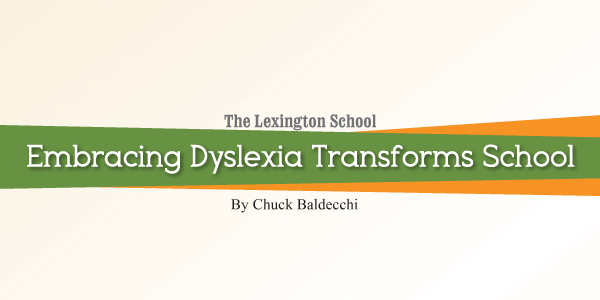The Lexington School: Embracing Dyslexia Transforms School
By Chuck Baldecchi
 Every school would love to have Aden as a student – a bright, engaged and talented young man. We at The Lexington School, a PK-8 school with 596 students, are proud to call him one of ours.
Every school would love to have Aden as a student – a bright, engaged and talented young man. We at The Lexington School, a PK-8 school with 596 students, are proud to call him one of ours.
Earlier this year, Kentucky Poet Laureate George Ella Lyon put out a call to all state residents regardless of age to write a poem celebrating “place.”
She chose Aden’s poem to represent Fayette County, and our school was justifiably proud of our sixth-grade writer.
But here is the extraordinary thing: Aden is severely dyslexic. While he can read and write, he relies heavily on the aid of Books on Tape and Dragon Dictation. Aden dictated his poem.
Here’s the other remarkable thing: If The Lexington School had not decided to open a school within a school for students with dyslexia and other language-based learning differences, Aden wouldn’t be a student at TLS.
The Origins
Let’s rewind to 2008 when my wife and I received a dinner invitation from Brutus and Sarah Clay, parents at TLS.
Brutus was technically a TLS alumnus. I say technically because Brutus was asked to leave The Lexington School after kindergarten. Yes, kindergarten.
Brutus could not read very well. He later discovered he was severely dyslexic.
When I heard this story, I was dumbfounded that Brutus sent his children to TLS. But Brutus has an eternally positive and resilient spirit – he doesn’t hold grudges.
“I have an idea to run by you,” Brutus said during dinner. “What if The Lexington School considered opening a school for dyslexic students? Would you be open to this idea?”
Immediately, I responded, “Yes.”
Five years earlier, I would have laughed and dismissed Brutus. But that night, Brutus described commuting 90 minutes each way to Louisville as a child to attend The de Paul School.
Sarah, his wife, talked fondly of The Hill Center, a school for dyslexic students in Durham, North Carolina.
Sarah had taught at Durham Academy, where The Hill Center was founded. My wife and I shared stories of family members with dyslexia.
The next day, Brutus wrote a letter to the president of our school’s board of trustees asking the board to study his idea, which the board agreed to do.
I was part of a task force that conducted research. We called multiple schools nationwide and made site visits to three schools, each with a different model.
After six months, we presented our findings to the full board.
Members were full of questions and worried about the cost of the program and its effect on the school’s reputation.
Several task force members left the meeting feeling dejected.
Not Brutus. He had spent a lifetime overcoming obstacles.
“Cheer up everyone. We are going to make this program happen,” he said as he rallied his troops.
And we did. Over the summer, we raised more than $600,000 in seed money. Brutus wrote a 10-year financial plan.
We discovered that with as few as eight students, TLS could make the financials work.
An architect, who is dyslexic, donated his time and designed the classrooms at one-tenth of the original cost.
Most important, our program director, Jane Childers, was already on staff.
We were on our way toward creating a school within a school.
Tremendous Growth and Benefits
The Learning Center opened in 2010, enrolling 16 students between first and sixth grades. In January, the number reached 20.
The following fall, 32 students enrolled. The numbers continued to climb until we hit capacity of 53 in 2015.
Students from first through eighth grades have enrolled. Families have moved from New Jersey, Tennessee and Eastern Kentucky to attend the program.
Meanwhile, our total enrollment has increased from 505 students in 2009 to 596 for fall 2016.
Improving classroom instruction and faculty professional development have been other major benefits to starting The Learning Center.
Now that we have a program for students with language-based learning differences, our regular classroom teachers can plan class for a student body with more similar learning abilities and spend more time meeting their needs.
In addition, teaching has improved school-wide because of our decision to start a school within a school.
Childers, The Learning Center director, shares her expertise with the entire faculty.
For example, she teaches using the Orton-Gillingham methodology, which has been proven to improve the progress of all budding readers regardless of whether they have been diagnosed with dyslexia.
Overall Benefit: Improved School Culture
I am proud of The Learning Center at The Lexington School for so many reasons.
• We have changed countless lives.
• Students who once hated school now love it.
• Siblings stay together.
• Parents whose children had lost the light in their eyes are grateful because the light has returned.
• All of our students play together, sing together, eat together, graduate together, learn together and grow together.
• Board members who first objected to the idea have written Brutus to say the Center is what they are most proud of when they reflect on their tenure on the board.
• We have given every student a voice.
• We have given each student a sense of place.
Chuck Baldecchi is entering his 13th year as Head of School at The Lexington School.
Photo:The Learning Center at The Lexington School has not only helped students with dyslexia but all instruction.

